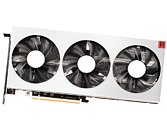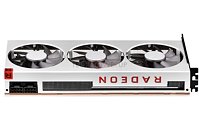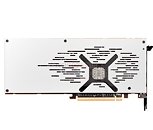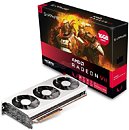Wednesday, January 23rd 2019

Sapphire Launches its Radeon VII, AMD Reserving 1.80 GHz Boost for Direct Sales?
Sapphire is among the first AMD add-in-board (AIB) partners to launch a Radeon VII graphics card. The card sticks to AMD reference board design, which the company unveiled at its CES 2019 keynote. Interestingly, its GPU engine boost frequency is set at 1750 MHz, which is less than the 1800 MHz boost frequency figure that was mentioned by the company earlier. Could it be that AMD is reserving 1800 MHz for cards directly sold on AMD.com? The memory frequency is unchanged at 1000 MHz, which works out to an HBM2 memory bandwidth of 1 TB/s. Sapphire's box for this card lists out key specifications upfront, and also features the Vega II logo. It's likely that the card will be sold at the baseline price of $699, given that there are no other variants of this card, not even custom-design.





38 Comments on Sapphire Launches its Radeon VII, AMD Reserving 1.80 GHz Boost for Direct Sales?
Also Can we please stop calling it vega II? I understand that is what it looks like but AMD clearly stated its Radeon 7 not labeled as Vega 2. I don't really care but it would be nice to represent the card as what it actually is called.
1.8 GHz could also be binned chips that Sapphire isn't getting shipments of. Maybe Sapphire manufactured the reference cards and these are the left overs?
www.sapphiretech.com/productdetial.asp?pid=97FA4A9F-D64C-45E6-A0C4-B8911A7EE2B3&lang=eng
Specs are unlikely to be different between vendors and even AMD themselves. This is a reference card with stickers.
Besides, this matches perfectly with what AMD presented. Remember, 1800MHz is peak clock and later it was clarified that Peak is higher than Boost.
- Base: 1400MHz
- Boost: 1750MHz
- Peak: 1800MHz
I really, really, really hope Navi brings some proper architectural efficiency improvements. Nvidia did it with Maxwell, so it must be possible, and I'd love an upgrade candidate for my Fury X to actually arrive at some point.
If you just mean "standard rounding" where you round up at a 1/2, maybe, but I think that's still a stretch, especially when they always quote MHz as the number looks bigger sand it is marketing ... ;)
I'm surprised they done put 1,750,000,000Hz. ;)
Incoming: Next nV product will be listed as "2,500,000,000 Hz. JH ("LJ" to his mates) is already quoting 1/4 FP numbers for the TFLOPS of their cards instead of the usual 32bit ...
Then again, it could be that console refresh cycles and AMD's architecture development times just don't align - it could happen, if the arch update turns out to be very challenging - but again that sounds unlikely given the mutual dependence between these parties. Console makers could theoretically go to Nvidia, but it's highly unlikely they'd get the performance they want for the prices they want, and that would likely break (or significantly hurt) compatibility with all previous software. It's not like they can re-use PC drivers, after all. As such, console makers need a significant update from AMD for ~2020, and are unlikely to adopt an untried, 1st-gen architecture, while AMD needs the continued business of console makers. If Navi doesn't bring a noticeable efficiency improvement, I don't see how they could launch a new generation of consoles at that point.Next up: near-infinite performance* with the next generation of cards.
*(in 1-bit calculations).